Chapter: 10th Science : Chapter 4 : Electricity
System of Resistors
SYSTEM OF RESISTORS
So far, you have learnt
how the resistance of a conductor affects the current through a circuit. You
have also studied the case of the simple electric circuit containing a single
resistor. Now in practice, you may encounter a complicated circuit, which uses
a combination of many resistors. This combination of resistors is known as
ŌĆśsystem of resistorsŌĆÖ or ŌĆśgrouping of resistorsŌĆÖ. Resistors can be connected in
various combinations. The two basic methods of joining resistors together are: ![]()
![]()
a) Resistors connected
in series, and b) Resistors connected in parallel.
In the following
sections, you shall compute the effective resistance when many resistors having
different resistance values are connected in series and in parallel.
1. Resistors in series
A series circuit
connects the components one after the other to form a ŌĆśsingle loopŌĆÖ. A series
circuit has only one loop through which current can pass. If the circuit is
interrupted at any point in the loop, no current can pass through the circuit
and hence no electric appliances connected in the circuit will work. Series
circuits are commonly used in devices such as flashlights. Thus, if
resistors are connected end to end, so that the same current
passes through each of them, then they are said to be connected in series.
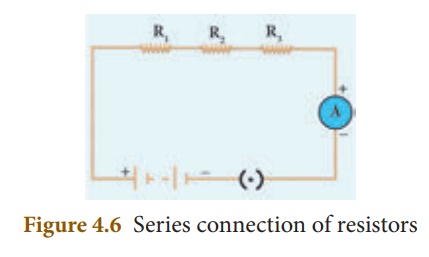
Let, three resistances R1,
R2 and R3 be connected in series (Figure 4.6). Let the current
flowing through them be I. According to OhmŌĆÖs Law, the potential differences V1,
V2 and V3 across R1, R2 and R3
respectively, are given by:
V1 = I R1
(4.7)
V2 = I R2 (
4.8)
V3 = I R3
(4.9)
The sum of the potential differences
across the ends of each resistor is given by:
V = V1 + V2 +
V3
Using equations (4.7),
(4.8) and (4.9), we get
V = I R1 + I R2
+ I R3 (4.10)
The effective resistor
is a single resistor, which can replace the resistors effectively, so as to
allow the same current through the electric circuit. Let, the effective
resistance of the series-combination of the resistors, be RS. Then,
V = I RS
(4.11)
Combining equations
(4.10) and (4.11), you get,
I RS = I R1
+ I R2 + I R3
RS = R1
+ R2 + R3 (4.12)
Thus, you can understand
that when a number of resistors are connected in series, their equivalent
resistance or effective resistance is equal to the sum of the individual
resistances. When ŌĆśnŌĆÖ resistors of equal resistance R are connected in series,
the equivalent resistance is ŌĆśn RŌĆÖ.
i.e., RS = n
R
The equivalent
resistance in a series combination is greater than the highest of the
individual resistances.
Solved Problem
Three resistors of
resistances 5 ohm, 3 ohm and 2 ohm are connected in series with 10 V battery.
Calculate their effective resistance and the current flowing through the
circuit.
Solution:
R1 = 5 Ōä”, R2 = 3 Ōä”, R3 = 2 Ōä”, V = 10 V
Rs = R1 + R2 + R3, Rs = 5 + 3 + 2 = 10,
hence
Rs = 10 Ōä”
The current, I = V/Rs = 10/10 = 1 A
2. Resistances in Parallel
A parallel circuit has
two or more loops through which current can pass. If the circuit is
disconnected in one of the loops, the current can still pass through the other
loop(s). The wiring in a house consists of parallel circuits.
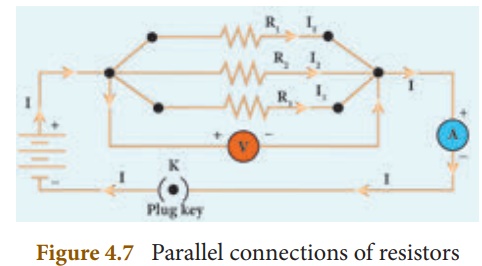
Consider that three
resistors R1, R2 and R3 are connected across
two common points A and B. The potential difference across each resistance is
the same and equal to the potential difference between A and B. This is
measured using the voltmeter. The current I arriving at A divides into three
branches I1, I2 and I3 passing through R1,
R2 and R3 respectively.
According to the OhmŌĆÖs
law, you have,
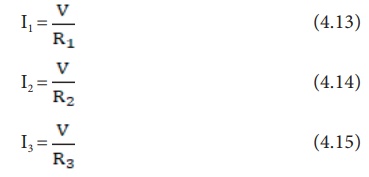
The total current
through the circuit is given by
I = I1 + I2
+ I3
Using equations (4.13),
(4.14) and (4.15), you get

Let the effective
resistance of the parallel combination of resistors be RP. Then,

Combining equations
(4.16) and (4.17), you have
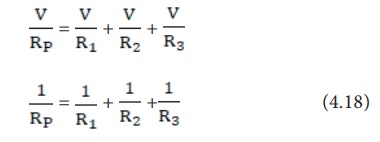
Thus, when a number of
resistors are connected in parallel, the sum of the reciprocals of the
individual resistances is equal to the reciprocal of the effective or
equivalent resistance. When ŌĆśnŌĆÖ resistors of equal resistances R are connected
in parallel, the equivalent resistance is R/n.
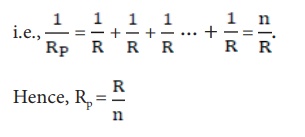
The equivalent
resistance in a parallel combination is less than the lowest of the individual
resistances.
3. Series Connection of Parallel Resistors
If you consider the
connection of a set of parallel resistors that are connected in series, you get
a series ŌĆō parallel circuit. Let R1 and R2 be connected
in parallel to give an effective resistance of RP1. Similarly, let R3 and
R4 be connected in parallel to give an effective resistance of RP2.
Then, both of these parallel segments are connected in series (Figure 4.8).
Using equation (4.18),
you get
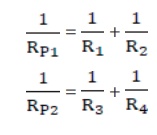
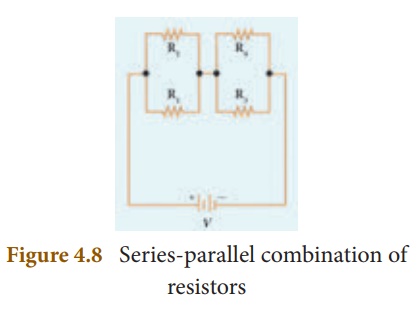
Finally, using equation (4.12), the
net effective resistance is given by Rtotal = RP1 + RP2
4. Parallel Connection of Series Resistors
If you consider a
connection of a set of series resistors connected in a parallel circuit, you
get a parallel-series circuit. Let R1 and R2 be connected in series to give an
effective resistance of RS1. Similarly, let R3 and R4 be connected in series to
give an effective resistance of RS2. Then,both of these serial segments are
connected in parallel (Figure 4.9).
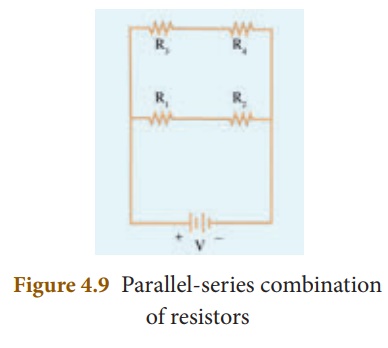
Using equation (4.12),
you get
RS1 = R1
+ R2,
RS2 = R3
+ R4
Finally, using equation
(4.18), the net effective resistance is given by

5. Comparison between series and parallel connections
The difference between
series and parallel circuits may be summed as follows in Table 4.3

Related Topics